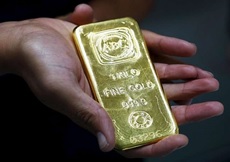How Long Until The Gold Price Passes Last Year’s High: Days, Weeks Or Months?

 After a dramatically positive and volatile week for the gold price with $1,279 an ounce the high point last Friday, it might seem churlish to quibble about how long it will take to pass the $1,309 high set in February 2015, perhaps the final hurdle to pass to decisively escape the four-year bear market.
After a dramatically positive and volatile week for the gold price with $1,279 an ounce the high point last Friday, it might seem churlish to quibble about how long it will take to pass the $1,309 high set in February 2015, perhaps the final hurdle to pass to decisively escape the four-year bear market.
Actually technically gold did manage that last week. The precious metal is already more than 22 per cent off its low of last December which marked out the double-bottom that this columnist correctly identified somewhat ahead of the pack.
Gold fund inflows surge
Gold fund inflows are running at their highest levels for seven years with $7.9 billion added in the past four weeks according to Bank of AmericaMerrill Lynch data. Indeed, gold funds are struggling to keep up with demand for the precious metal.
BlackRock has suspended issuance of new shares of its iShares Gold Trust after it attracted $1.4 billion in new money this year. Then came the ultimate call for gold on Friday with JP Morgan revealed as switching to overweight gold and underweight US equities.
That almost certainly accounted for the spike in gold prices on Friday. When the world’s leading bullion bank and Wall Street titan speaks then even the most junior trader pays attention.
The question then is whether all this momentum leaves gold overbought and ripe for a pullback. It would not be the first time that a US investment bank put out a buy order to take profits for itself.
Chartists beaten-up
Technical chartists are not much help. There is a split between those who see a bullish pennant or flag in the recent consolidation and breakout in the gold price; and those calling last Friday’s mini-spike in the gold price a ‘gravestone’ predicting a correction this week.
To make things even more complicated the S&P 500 failed to break the psychologically important 2,000 barrier last week, and futures look negative. Recent stock sell-offs have been accompanied by higher gold prices but then again so has the rally that now puts US equities on a level pegging for the year.
So I would prefer to focus on fundamentals and think rather beyond the next week of trading about gold. These tea leaves offer a much clearer view of the future.
The shift towards negative interest rates by global central banks is a major macro-economic concern for investors. Put your money into bank deposit accounts in Japan and the eurozone and it is literally going to shrink in value.
Cash piles
What is a big corporation supposed to do? Turn its money into paper cash and stash that in a safe? Some private concerns are apparently doing just that.
Or you could change your shrinking paper deposits into the oldest money known to mankind. Gold does not pay interest, but it does not charge it either unlike euro or yen deposits.
Even the Federal Reserve has been muttering about considering the possibility of negative rates as an extreme policy response. That was before a rather good US jobs report on Friday which helped to rally stocks to a level that recovers the losses of 2016, though the gold price closed just $20 off its highest for this year.
It is amazing how sentiment towards gold has changed since last December. Gold has become a classic hedge again.
Classic hedge
On the one hand, investors fear lower interest rates and currency depreciation and gold is a hedge. On the other, some fret about a resurgence of US inflation expectations because the economy could soon face capacity constraints in the labor market leading to higher salaries, though strangely there is absolutely no sign of it in last week’s jobs report.
Spot the momentum driving those record gold exchange traded product inflows. Could something happen to dent enthusiasm for a few days? Could JP Morgan’s conversion to gold mark an interim top?
Anything is possible in the short term which is why following technical charts with religious zeal is a way to lose money rather quickly. But the longer term buy-and-hold strategy would seem confirmed as those who are still sat on the sidelines have lost out in 2016, and a new low for the gold price correction now looks very unlikely.
What happens next? The US stock market rally has probably run its course and a resumption of the weakness seen at the start of the year is likely. JP Morgan is warning its clients of a 30 per cent slump coming for stocks as the current weakness of the global economy catches up with profit forecasts.
Stock market crash
That’s something that is pretty easy to crunch out of the current data flow. It is not wild speculation, and of course a US recession is now overdue as the great commodities guru Jim Rogers pointed out last week.
Look beyond the USA and there’s an awful lot going wrong in the global economy. The Bank of International Settlements just published figures showing around $80 billion is being pulled out of the Chinese economy each month at the moment, say $1 trillion in a year or half the GDP of the UK or Russia.
It’s a phenomenal imbalance and where is that money going to go? Vancouver condominiums, up 25 per cent in the past year? Well clearly it has the potential to create bubbles in many asset classes, or at least the few that are still perceived as having fundamental value.
George Soros said in the global financial crisis that gold was always the ‘ultimate bubble’ and some thought that he meant gold was then in a bubble. But that was a misinterpretation. Gold is the ‘ultimate bubble’ in terms of being the last man standing in financial crisis.
If we are heading for chaos in global bond markets due to negative interest rates and a crash in major stock markets then where else will all that money flooding out of China go? Gold.

















